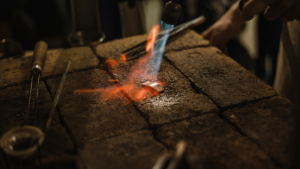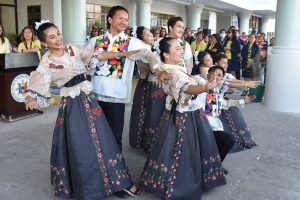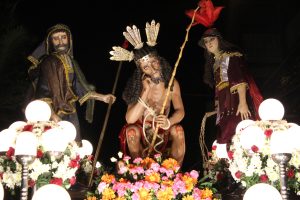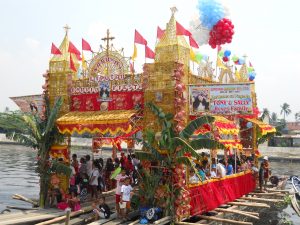JEWELRY MAKING

It was widely believed that the Chinese goldsmith settled in Meycauayan, Bulacan. The art of jewelry making was then introduced and thought to the townsfolk, which was later handed down through generation to their offspring’s. This became Meycauayan major industry. Some craftsmen to avoid too many competitions migrated to other provinces, which helped spread the trade. Admittedly this technology was a legacy to the Filipino by our Chinese forebears. This explains why some of our handstools and other equipments were of Chinese word and names like: working tables were termed tokoy, gold as lebua, scrap alloyed as teho, and pure gold or 24k were colloquially termed as tsina.
Before, the relatively small establishments in Meycauayan are not interested in modern technology. They were satisfied with the existing facilities and not keen on investing large capital in the purchase of modern equipment to upgrade quality standard to their products. They believed that the exquisite finish skilled craftsmen could accomplish by hand was lacking in the machine made jewelry. As can be expected they insisted in using as much hand work as possible and rejected the idea of heavy machinery to mass products despite the difficulty in recruiting craftsman and apprentices. Now about 60% of the factories are equipped with modern tools, equipments and machineries like casting and stamping machines.
P. ZUÑIGA
Malhacan, City of Meycauayan, Bulacan
0917-817-7775
kitsilver jewellery
Iba, City of Meycauayan, Bulacan
0927-644-3454
kyle jewelry
Calvario, City of Meycauayan, Bulacan
0922-539-1787 / 0998-540-5922
nl jewelry & jewellery tools supply
Calvario, City of Meycauayan, Bulacan
(044) 840-9396
goldenhills jewelry
Saluysoy, City of Meycauayan, Bulacan
0917-517-0811
TANNING INDUSTRY

The tanning industry began in the Philippines in 1903 and was first established in Meycauayan, Bulacan. It was believed that Chinese craftsmen started the primitive way of tanning leather in the province. Most of these firms are in Meycauayan, making it the seat of the tanning industry in the Philippines. Not only is Meycauayan accessible to raw materials (hides and skins from Metro-Manila), it is also near the market for finished leather, that is, footwear in Marikina, leather goods in Metro Manila and sub-urbs, and the export processing zone in Bataan. A few tanneries are located in the towns of Valenzuela, Guiguinto and the nearby towns of Navotas and Malabon.
During the 50’s and 60’s, majority of the tanneries were located in Barangays Banga, Bancal and Hulo. In the 70’s, the Municipality of Meycauayan declared Barangay Tugatog as an industrial site for tanneries because of the cheap cost of land and its accessibility to rivers and creeks for waste disposal.
There are different kinds of tanneries here on Meycauayan. There are large sized firms of tanneries that process more than two tons of raw skins/ hides per day. Next are medium sized firms that process 200 kilograms to two tons per day and the other are small sized firms that commonly process semi- finished leather and sell it to larger size tanneries that process it to finished leather goods.
chelsi leather & services, inc.
Tugatog, City of Meycauayan, Bulacan
(044) 840-2188
goldenhills jewelry
Bancal, City of Meycauayan, Bulacan
(044) 935-3891
great buffalo manucfacturing
Libtong, City of Meycauayan, Bulacan
(044) 935-3891
culture (tradition & festival)
culebra

The first church was destroyed by a typhoon in 1588 and the town proper was moved to Lagolo. The construction of the present church was started shortly after its transfer to the present site in 1668. Fray Francisco Gascueña, O.F.M., who builds the belfry in 1800, preached the gospel in China for six years, and on being exiled from that kingdom out of opposition to his religious teachings returned to Meycauayan. He served this parish for 31 years and died here on November 18, 1831. The convent was built from 1731 to 1759. It also served as Escuela Parroquial and became headquarters of the Revolutionary government in 1898, where the Philippine Flag was first raised in the town. The First election in Meycauayan was held in the church convent by Major William A. Kobbe.
The church was destroyed by a massive fire in April 4, 1949, known as the Great Fire of Meycauayan. Artefacts such as old memorabilia are some of the casualties of the fire and the retablo built by Fray Benito de Madridejos in 1854 was destroyed. Only a few church items including the tabernacle were saved from the fire. Together with other collected artefacts, it is now housed in the Museo Parrochial de Meycauayan established in 2014.
After its destruction, reconstruction of present structure soon follows and further developments were added. Attempts to bring back its old glory was always there, however legit church’s restoration effort was only done in 2020 where the church interior was restored and the Old retablo was reconstructed.
lenten procession

The City of Meycauayan is one of the towns in Bulacan that has its colourful Semana Santa celebration. Normally the Lenten season is observed with a week-long fasting and abstinence as well as traditional Cenaculo, Visita Iglesia and Pabasa in many times. Processions also play significant roles in celebrating Holy Week.
The Holy Wednesday and Good Friday Procession in Meycauayan had 54 massive Carrozas carrying life-sized dioramas portraying the life and passion of Jesus Christ. This solemn rite was attended by numerous local and foreign tourists every year.
liputan fluvial parade

For a typical citizen of Meycauayan, Liputan is best associated w ith the fluvial parade that usually happens on the second Sunday of May. This year, however, it is celebrated on the first, given that it is only now that we have low tide for the entire month.
Of all fiestas in Meycauayan, the fiesta of Liputan is the most extravagant, lively and well-known. It starts early in the morning when the image of Mahal na Señor is placed on their carriages and then taken to the city on a big makeshift boat called a pagoda.
